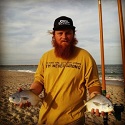 With our country’s 23 coastal states, and over 75,000 miles of coastline, it’s easy to understand America’s fascination with surf fishing. Alaska, Florida and California rank first, second and third for the most coast line, while New Hampshire, Delaware and Maryland rank 21st, 22nd, and 23rd, with the least amount of shoreline.
With our country’s 23 coastal states, and over 75,000 miles of coastline, it’s easy to understand America’s fascination with surf fishing. Alaska, Florida and California rank first, second and third for the most coast line, while New Hampshire, Delaware and Maryland rank 21st, 22nd, and 23rd, with the least amount of shoreline.
It is a fascinating thought that thousands of surf anglers are exploring the extreme far corners of our nation’s coast at any given time for a multitude of fish species. Twenty or thirty years ago there was very little written or mentioned concerning surf fishing in national publications, or on the ever-popular fishing TV shows. Back then, only the wisest anglers were paying any serious attention to the many rewarding opportunities connected to surf fishing.
Today there is still a select group of anglers hunting their favorite beaches for trophy catches, be it a striped bass, flounder, shark, spotted seatrout, snook, tarpon or salmon. However, today there are a lot more ‘not so serious’ anglers trying surf fishing; some to enjoy time outdoors in the fresh air and to take in the diversity of the sights, and others just looking to catch a fresh fish dinner.
While the number of people living in coastal communities continues to increase dramatically, not everyone can live on or near the beach, and in fact, the vast majority of surf anglers drive to their favorite beachside locations to do their surf fishing. So the question, “What makes a great surf fishing destination?” is very important to any angler wanting to improve his surf fishing efficiency. In my opinion, one needs to consider a combination of several factors to determine the answer. Continue reading at this link – http://rodneysmithmedia.com/going-surf-fishing/

